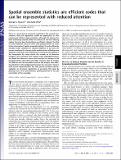| dc.contributor.author | Alvarez, George A. | |
| dc.contributor.author | Oliva, Aude | |
| dc.date.accessioned | 2009-12-28T19:20:22Z | |
| dc.date.available | 2009-12-28T19:20:22Z | |
| dc.date.issued | 2009-04 | |
| dc.date.submitted | 2009-03 | |
| dc.identifier.issn | 0027-8424 | |
| dc.identifier.uri | http://hdl.handle.net/1721.1/50262 | |
| dc.description.abstract | There is a great deal of structural regularity in the natural environment, and such regularities confer an opportunity to form compressed, efficient representations. Although this concept has been extensively studied within the domain of low-level sensory coding, there has been limited focus on efficient coding in the field of visual attention. Here we show that spatial patterns of orientation information (“spatial ensemble statistics”) can be efficiently encoded under conditions of reduced attention. In our task, observers monitored for changes to the spatial pattern of background elements while they were attentively tracking moving objects in the foreground. By using stimuli that enable us to dissociate changes in local structure from changes in the ensemble structure, we found that observers were more sensitive to changes to the background that altered the ensemble structure than to changes that did not alter the ensemble structure. We propose that reducing attention to the background increases the amount of noise in local feature representations, but that spatial ensemble statistics capitalize on structural regularities to overcome this noise by pooling across local measurements, gaining precision in the representation of the ensemble. | en |
| dc.description.sponsorship | National Science Foundation | en |
| dc.description.sponsorship | National Science Foundation | en |
| dc.description.sponsorship | National Institutes of Health/National Eye Institute | en |
| dc.language.iso | en_US | |
| dc.publisher | National Academy of Sciences | en |
| dc.relation.isversionof | http://dx.doi.org/10.1073/pnas.0808981106 | en |
| dc.rights | Article is made available in accordance with the publisher's policy and may be subject to US copyright law. Please refer to the publisher's site for terms of use. | en |
| dc.source | PNAS | en |
| dc.title | Spatial ensemble statistics are efficient codes that can be represented with reduced attention | en |
| dc.type | Article | en |
| dc.identifier.citation | Alvarez, George A, and Aude Oliva. “Spatial ensemble statistics are efficient codes that can be represented with reduced attention.” Proceedings of the National Academy of Sciences 106.18 (2009): 7345-7350. | en |
| dc.contributor.department | Massachusetts Institute of Technology. Department of Brain and Cognitive Sciences | en_US |
| dc.contributor.approver | Oliva, Aude | |
| dc.contributor.mitauthor | Oliva, Aude | |
| dc.relation.journal | Proceedings of the National Academy of Sciences of the United States of America | en |
| dc.eprint.version | Final published version | en |
| dc.identifier.pmid | 19380739 | |
| dc.type.uri | http://purl.org/eprint/type/JournalArticle | en |
| eprint.status | http://purl.org/eprint/status/PeerReviewed | en |
| eprint.grantNumber | 0705677 | en |
| eprint.grantNumber | CAREER Award 0546262 | en |
| eprint.grantNumber | F32EY016982 | en |
| dspace.orderedauthors | Alvarez, G. A.; Oliva, A. | en |
| mit.license | PUBLISHER_POLICY | en |
| mit.metadata.status | Complete | |
